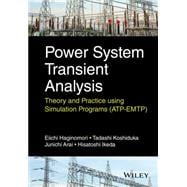Understanding transient phenomena in electric power systems and the harmful impact of resulting disturbances is an important aspect of power system operation and resilience. Bridging the gap from theory to practice, this guide introduces the fundamentals of transient phenomena affecting electric power systems using the numerical analysis tools, Alternative Transients Program- Electromagnetic Transients Program (ATP-EMTP) and ATP-DRAW. This technology is widely-applied to recognize and solve transient problems in power networks and components giving readers a highly practical and relevant perspective and the skills to analyse new transient phenomena encountered in the field.
Key features:
- Introduces novice engineers to transient phenomena using commonplace tools and models as well as background theory to link theory to practice.
- Develops analysis skills using the ATP-EMTP program, which is widely used in the electric power industry.
- Comprehensive coverage of recent developments such as HVDC power electronics with several case studies and their practical results.
- Provides extensive practical examples with over 150 data files for analysing transient phenomena and real life practical examples via a companion website.
Written by experts with deep experience in research, teaching and industry, this text defines transient phenomena in an electric power system and introduces a professional transient analysis tool with real examples to novice engineers in the electric power system industry. It also offers instruction for graduates studying all aspects of power systems.








